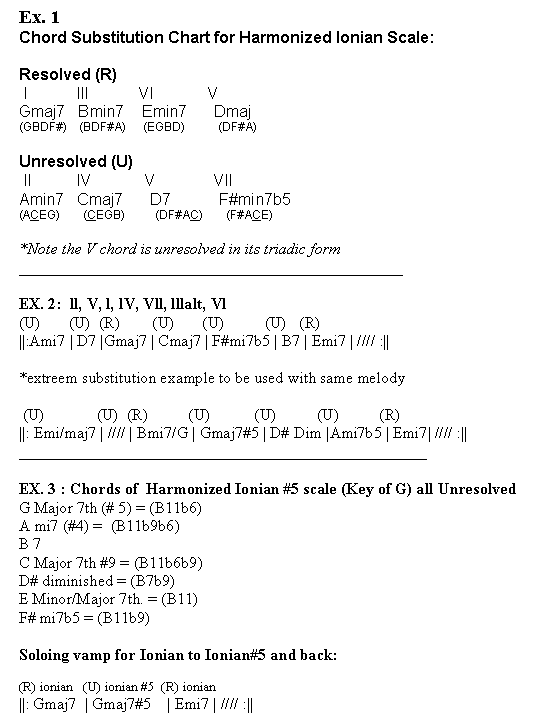GUEST COLUMNIST:

Master Theory Class Part ll : “Ionian #5” The Harmonic Minor Scale soloing and
chord substitution made simple through theoretical refocusing.
This is part II of my Master Theory Class lessons. In order to fully understand the following I recommended that you refer back to part l for a complete description of my resolved and unresolved concept. (See Ex: 1)A great chord progression to begin with when applying the resolved and unresolved concept would be what's known as a 2, 5, 1, 4, 7, 3Maj, 6 (See Ex.2). These chords are taken from the Harmonized Major Scale and arranged in a cycle of fourths, and starting on the ll chord. If your into jazz these are the chords to the beginning 8 bars of the song "Autumn Leaves" (found in any real book). But don't get nervous this progression is universal and is the basis (in its entirety or in parts) for thousands of songs in all musical styles. Using the resolved and unresolved principle found in part 1 the ll chord would be U (unresolved). Meaning that in the key of G the fourth note C as well as the other 6 notes of the scale would be fine for soloing over unresolved chords. For resolved chords we avoid or put less emphasis on that 4th degree (See Ex.1)
As seen again in Ex. 1 and 2 the ll. and V chords, are (U) unresolved. The l chord is resolved (R), again using chords found in the resolved column as substitutes. The lV chord followed by the Vll are unresolved (U). Which brings us into the world of Harmonic Minor the lll chord in any Major key is supposed to be Minor (resolved) but like most Latin or classically based songs for example the lll chord is Major (dominant) bringing out the sound of Harmonic Minor. The lllmaj. or lll 7 in this case is (U) unresolved because it has been altered from its original function and is interchangeable with all the other unresolved chords of the original Major key. Next is the Vl chord, which is resolved (R). In summation all chords in their respective unresolved and resolved categories are interchangeable among themselves allowing the original melody to be maintained yet nicely re-harmonized.
So lets look at the lll chord being major instead of minor and in doing so introducing us to the Harmonic Minor sound. Most music theorist focus on the Relative Minor scale know as the Aeolian mode or even Natural Minor when the lll major is played. They then raise that scales 7th creating Aeolian natural 7 which is a mode of Harmonic Minor and misinterpreted by many as the new parent scale thus totally complicating a very simple issue.
What is the 3rd in a B minor chord? It's a D. (B, C, D). In the key of G major (G Ionian), the D is the 5th note of the scale G, A, B, C, (D) E, F#, G. But in the case of a B Minor chord turning into a B Major the D becomes D#. Which means you raise the minor third of the B Minor chord to a Major 3rd, creating a B Major or B7 chord. So the more sensible approach is to see how this change affects the original Ionian key not the Relative Minor!!! What you end up with is Ionian #5 G, A, B, C, D#, E, F#, G. So instead of trying to figure out where the harmonic minor scale is related to relative minor, just take your Major scale (Ionian) and raise the 5th note one half step. It's that simple! Whenever you feel like playing in Harmonic Minor instead of playing Ionian play Ionian # 5. You don't have to think about anything else other than raising the 5th note of Ionian to be in Harmonic Minor for soloing. Resolve that #5 to a 1,3 or 6 when you want to resolve back to the original Ionian Key.
Like is said the lll7 chord is considered a U (unresolved) and is interchangeable with the other U's of the Ionian scale. As an added bonus ALL the chords of Ionian #5 (Harmonic Minor scale) are considered unresolved and are substitutes in the U category as well. (Ex.3) . An excellent exercise would be to record the melody to “Autumn Leaves” and or any other melody that works well with the original changes 2, 5, 1, 4, 7, 3Maj, 6 and substitute chords i.e.: R's for R's and U's for U's (and those from Ionian#5) underneath. You'll find countless harmonic possibilities as well as acquiring a much better command and understanding of soloing over changes using this Ionian / Ionan #5 concept. So have fun!
Paul Nelson
PAUL NELSON A top recording artist and session player touring with countless international acts his guitar work has been heard nationally on NBC, WWF, TNN, UPN television. Studying under Steve Vai, Steve Khan, and Mike Stern early on he has recently performed as part of the Johnny Winter group as well as writing for and playing on the Rock/Blues Legend's latest Grammy nominated Virgin/EMI release. His highly acclaimed solo CD entitled "LOOK" has been released worldwide. Paul is an endorsement artist for Ernieball/Musicman and DiMarzio products. For questions, comments and more visit: www.paulnelsonguitar.com and www.myspace.com/paulnelsonguitar.

